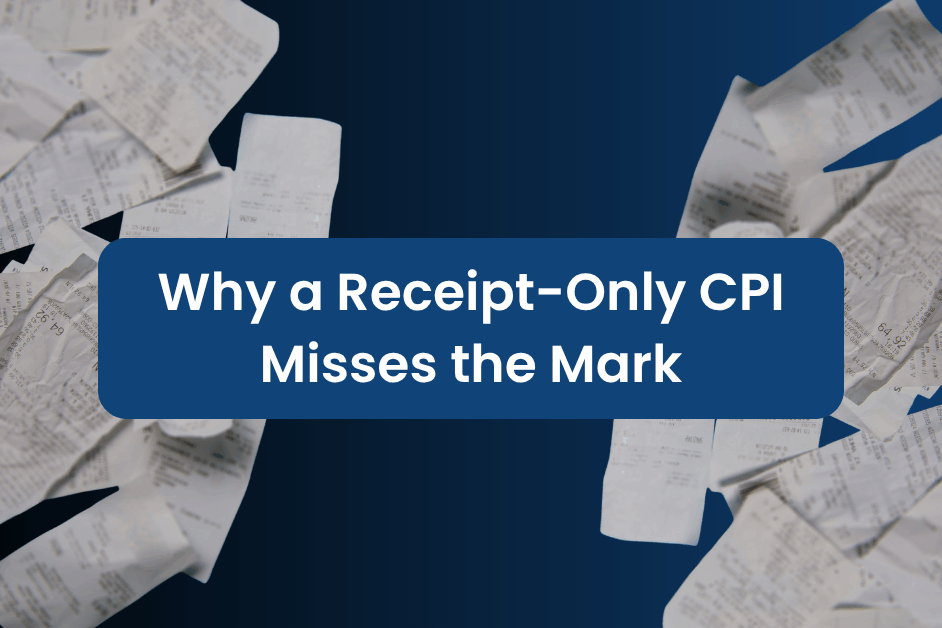This is the inaugural release of the OpenBrand Consumer Price Index (CPI) – Durable and Personal Goods report. This comprehensive report offers critical insights into price trends across major consumer product categories representing a select mix of both durable and personal goods (see methodology below for more detail). The data used in this report leverages OpenBrand’s industry-leading library of durable and personal goods pricing, promotion, and availability for over 200,000+ individual products. This more than doubles the coverage by the monthly Bureau of Labor Statistics (BLS) Consumer Price Index, which allows more timely and granular reporting of price changes in the market.
The below free monthly report provides a broad summary of price changes (including promotional activity), category-specific pricing and promotional trends, and macroeconomic context.
For those seeking deeper insights, weekly CPI reporting is available on a subscription basis with up to same-day SKU-level pricing data available in bulk downloadable files. Request more information about the offering below.
DISCLAIMER: This report is provided ‘as is’ for informational purposes only. OpenBrand makes no representations or warranties regarding the accuracy, completeness, or reliability of the data. Users assume all risks associated with their use of this report. OpenBrand shall not be liable for any losses or damages arising from the use of this report.
Table of Contents
- Key Takeaways for January 2025
- Product Group Highlights
- CPI 2025 Forecast: February 2025 Macroeconomic Summary
- Subscribe
- Methodology
- Product Group Breakdown
Key Takeaways for January 2025
Overall Index Movement: The OpenBrand CPI of Durable and Personal Goods recorded a 0.6% change in January, reflecting inflationary pressures in the market in anticipation of President Trump’s promise of tariffs on Canada, China, and Mexico. Although tariffs on Canada and Mexico have been postponed until early March, this is the second consecutive month of price increases and third of the past four months following a six-month deflationary trend in the second half of 2024.
Annual Trends: Year-over-year, durable and personal goods prices have decreased by 1.4%, indicating a broader downward trend in prices that reflects a lower rate environment compared to the same time last year. For perspective, the effective federal funds rate (EFFR) at the end of January 2025 was a full 100 basis points lower than the same period last year, suggesting that both consumers and wholesalers using debt to purchase goods have benefited from a lower rate environment.
Product Group Trends: All five product groups — Appliances, Communication, Home Improvement, Personal Care, and Recreation — showed positive month-over-month price growth in January.
- Recreation Group – which includes TVs, speakers, and headphones (+2.8%)
- Personal Care products (+1.1%)
- Home Improvement (0.6%)
- Appliances and Communication products (+0.4%).
See the full breakdown of product groupings.
Macroeconomic Summary: The broader U.S. economy remains healthy, with labor markets staying relatively tight at an unemployment rate of 4.1% and consumer spending up 0.7% in December. While the recent threats of tariff implementations pose potential inflationary risks to the economy, currency markets have priced most, if not all, of the expected increase in wholesale prices due to such tariffs over the past four months. It’s also important to note tariffs are typically applied to wholesale — not retail — prices. In both cases, we should expect the potential impacts of such tariffs on retail pricing, if or when they are implemented, will likely be less than the face value of the tariffs themselves.
Product Group Highlights
CPI: Appliances
Prices for appliances increased by 0.4% on a month-over-month basis in January, representing the second consecutive month of month-over-month gains with a cumulative price growth of nearly 1%. Though the magnitude of discounts on appliances has remained relatively stable over the past year at around 18%, the frequency of discounts has fallen slightly over the past month from 43.2% in December to 42.6%.
CPI: Communication
Prices of communication devices, including phones, tablets, computers, and printers, increased by 0.4% on a month-over-month basis. This is the fifth consecutive monthly increase, reflecting a counter-trend in the communications sector of inflationary pressures not seen in other consumer segments.
While the magnitude of discounts has increased slightly over the past few months – from 15.8% in May of last year to 18.6% in January 2025 – it was not enough to counter the sharp reduction in the frequency of discounts, with the share of retailers offering price discounts falling from 15% in August of last year to just 9.6% last month.
CPI: Home Improvement
The index for home-related durable goods moved up 0.6% on a month-over-month basis, the 27th consecutive month-over-month increase. While pricing growth has been persistently positive over the past two years, the sector continues to see a discount incidence in the double digits with 10.8% of products discounted in the month of January. Though this is down from 12.9% in December and 11% in November, the magnitude of discounts has remained steady at about 18%.
CPI: Personal Care
Prices of personal care products moved up by 1.3% on a monthly basis in January 2025, the second consecutive monthly increase and up from 1.1% in December. Much of this increase is due to a monthly decrease in the incidence and magnitude of price discounts, with the share of personal care products with discounts falling from 29% in December to 23.4% in January, with the average discount magnitude falling from 22.7% to 21.4% over the same period.
CPI: Recreation
Prices of recreational products, including TVs, headphones, and speaker systems, moved up sharply by 2.8% on a month-over-month basis after a cumulative decline of nearly 1% in November (-0.2%) and December (-0.7%) 2024. Much of this increase is due to a monthly decrease in the incidence and magnitude of price discounts, with the share of recreation products with discounts falling from 23.2% in December to 17.7% in January, with the average discount magnitude falling from 26.7% to 24.6% over the same period.
CPI 2025 Forecast
February Macroeconomic Summary
As of February 2025, the U.S. economy exhibits a blend of robust growth and emerging challenges. On the upside, the U.S. economy continues to demonstrate resilience, with Gross Domestic Product (GDP) growth projected to grow by 2.5% in 2025, driven primarily by strong consumer spending and productivity gains. While the labor market remains tight, the service sector experienced a slight slowdown in January but remains at robust levels to support consumer spending throughout the first half of 2025.
Impact of Tariffs on CPI
The recent threats of 25% tariff implementations on Mexico and Canada, and the actual 10% tariff implementation of China, pose potential inflationary risks to the economy. However, it’s important to note two facts when anticipating the impacts of such tariffs on pricing.
First, free currency markets — notably currency exchanges for Canadian Dollars and Mexican Pesos — have trended downward in recent months, likely reflecting a market expectation that President Trump would implement tariffs on imports from both countries. For example, between September 2024 — when prediction markets began favoring a Trump victory in the U.S. election — and December 21 — a month before President-Elect Trump would take office — currency markets devalued the Canadian Dollar by 24.8%. Over a similar time period, the Mexican Peso fell by 11.3%. This means that nearly the entire 25% tariff on Canadian goods and nearly half of the Mexican tariff had been priced in by currency markets.
Second, it’s also important to consider that tariffs on most consumer goods entering the U.S. are predominantly on wholesale goods. This means that even without currency market adjustments, we shouldn’t expect the amount of such proposed tariffs would be passed on to the consumer. While it’s tough to know what the markups on Canadian and Mexican imported goods are to the consumer, let’s proceed with two scenarios whereby markups are either 50% or 100%. Let’s suppose importers purchase $100 worth of goods from Canada and/or Mexico and pay the 25% tariff – which equals $25. This means the total cost of the goods for the importer is $125 in each scenario. If they pass the entire tariff amount onto the consumer, this means the imported goods will cost the consumer $175 ($100 wholesale + $50 markup + $25 tariff) in the case of a 50% markup and $225 ($100 wholesale + $100 markup + $25 tariff) in the case of a 100% markup. In these cases, the actual price increase to the consumer would be 16.7% in the scenario where markups are 50%, and 12.5% in the case of 100% markup.
When the first and second scenarios are combined, it seems reasonable to expect that the actual price increase to the consumer would be significantly less than the face value of the tariff. While we will be monitoring our pricing data intimately over the coming months to spot any observed price impacts of such tariffs, it’s possible the impact is small enough so as to be imperceptible in OpenBrand’s (and others’) pricing data.
While the U.S. economy is poised for continued growth in 2025, policymakers and business leaders remain vigilant regarding potential headwinds, including trade tensions and inflationary pressures. Ongoing monitoring of these factors will be crucial to sound economic positioning of retail businesses, policymakers, and the broader investment community.
Note: This summary is based on data available as of early February 2025 and may be subject to revisions in future releases.
Subscribe
Get CPI & Real-Time Pricing Data Updates
The OpenBrand CPI will be released on a monthly basis, with weekly updates coming soon. For email alerts on when the next month's CPI data is available, subscribe below.
OpenBrand Methodological Notes
The OpenBrand CPI of Durable and Personal Goods is constructed using a data-driven methodology that ensures accuracy, timeliness, and transparency in measuring price trends for both short and long-lasting consumer products. The methodology consists of the following key components:
1. Data Collection
- Real-Time Price Tracking: Prices are sourced daily from online marketplaces, retail websites, and brick-and-mortar store listings.
- Retailer & Manufacturer Data: Aggregates pricing information from major retailers, direct-to-consumer brands, and wholesale suppliers into broader consumer categories.
- Temporal Coverage: Captures price variations over time, including daily discounts and price promotions
2. Product Selection & Tracking
- Durable and Personal Goods Focus: The index includes products with an expected lifespan of three years or more, such as home appliances, consumer electronics, and tools, as well as personal care products with a shorter lifespan, such as hair and skin care products, vitamins, over-the-counter medications, and oral care products.
- Brand & Model Tracking: Individual brands and models are monitored to reflect pricing shifts within competitive product segments, including both permanent changes in listing price as well as temporary promotional pricing.
3. Price Calculation, Adjustments, and Weighting
- Price Calculation: Tracks month-over-month and year-over-year price movements to measure price stability in the marketplace and take into account both longer-term changes in pricing (such as changes in manufacturer’s suggested retail price) as well as more short-term changes in pricing, such as promotional discounts and sales prices.
- SKU-Removal Instead of Hedonic Adjustments: When a product (or SKU) becomes unavailable in the BLS goods basket, the BLS implements a SKU-replacement procedure whereby the next most similar product is used in its place, and a quality (hedonic) adjustment procedure is performed to get closer to an apples-to-apples price comparison. Since OpenBrand has data on nearly 100% of the SKUs pricing history in a given product category, we can simply remove that SKU from the basket and rely on price changes of the remaining SKUs in that basket. This eliminates the need for hedonic adjustment in the OpenBrand CPI basket.
- Weighting and Aggregation Method: A weighted geometric mean formula is used to minimize volatility and improve stability in price trend analysis at both the product grouping and category level. Instead of using sales-volume weights when aggregating the index, we take an alternative approach by using persistence-based weights for aggregation. Instead of more frequently purchased items getting more weight in the BLS’ CPI calculation, OpenBrand takes a more novel approach by weighting items with a more established price history in the market more heavily in our CPI calculation than items with a less established history.
4. Reporting & Updates
- High-Frequency Updates: Published freely on a monthly basis, with a subscription option for daily summaries across categories, sub-categories, and individual products.
- Comparative Benchmarks: We aggregate pricing as analogously as possible to traditional BLS CPI measures for benchmarking purposes.
- Transparency & Accessibility: Provides both open and paid data access for journalists, researchers, businesses, and policymakers.
By leveraging real-time data and advanced statistical techniques, the OpenBrand CPI offers an accurate and dynamic measure of pricing trends, helping businesses and consumers make informed decisions in an evolving economic landscape.
OpenBrand CPI – Durable and Personal Goods
Groups and Products
Appliance Group
Air Conditioners
Air Purifiers
Beverage Coolers
Blenders
Coffee Makers
Cooktops & Wall Ovens
Countertop Cooking
Countertop Microwaves
Dehumidifiers
Dishwashers
Dryers
Freezers
Icemakers
Laundry
Ranges
Refrigerators
Vacuums
Washers
OTR (Over-the Range Microwaves)
Communications Group
Business Printers
Desktops
Headsets
HED
Ink
Large Printers
MFP Copiers
Monitors
Notebooks
Personal & SOHO Printers
Projectors
Smartphones
Tablets & Detachables
Toner
Wearables
Wireless Routers
Home Improvement Group
Bathroom Faucets
Cutting Machines
Door Locks
Generators
Grass Seed
Handhelds
Hand Tools
Kitchen Cleanup
Kitchen Faucets
Lawn Fertilizer
Lawn Products
Log Splitters
Mowers
Outdoor Cooking & Accessories
Pesticides
Power Tools & Accessories
Pressure Washer
Replacement Batteries
Smart Doorbells
Smart Locks
Smart Cameras
Smart Thermostats
Snow Throwers
Weed Killer
Recreation Group
Bluetooth Speakers
Bluray
Digital Camcorders
Digital Cameras
Headphones
Media Players
Photo Paper
Sewing Machines
Sound Bars
Speaker Systems
TVs
VAW Speakers
Personal Care Group
Bath Products
Contraceptives
Cosmetics (Eye, Facial, Nail)
Deodorants
Diabetic Products
Digestive (Lower GI, Upper GI, Hemorrhoidal)
Ear Care Products
Eye Care Products
Feminine Needs (Sanitary Napkins/Tampons & Women’s Care)
First Aid Accessories & Treatments
Foot Care Products
Fragrance
Hair Care (Coloring, Growth, Shampoo, Conditioner, Styling)
Hair Dryers
Home Health Care
Lip Preparations
Oral Care (Breath Fresheners, Accessories, Dentures, Mouthwash, Oral Hygiene, Toothpaste)
Pain (Analgesic, External & Internal)
Sexual Wellness
Shave (Non-Razor Blades, Creams, Razors)
Skin Care (Acne, Facial, Hand & Body)
Sleeping Remedies
Soap
Sun Care
Upper Respiratory (Cold/Allergy/Sinus Liquids & Tablets, Cough Drops/Lozenges, External, Nasal Products)
Vitamins, Minerals & Supplements
Wt Ctl/Nutrition (Tablets & Liquid, Powder Wipes, Towelettes)
PREPARED BY
Ralph McLaughlin
Ralph McLaughlin is Chief Economist at OpenBrand, bringing nearly two decades of experience in economics, data analytics, and forecasting. His expertise spans industrial economics, applied econometrics, and housing market dynamics. Previously, he served as Chief Economist at Trulia and Haus, Deputy Chief Economist at CoreLogic, and Senior Economist at Realtor.com. Ralph held academic appointments at USC, San Jose State University, and University of South Australia. He earned a PhD in planning, policy, and design from UC Irvine and a BA in geography and regional development from the University of Arizona. Ralph is also an FAA-certified commercial pilot and instructor.
Contact Us
For questions about the report, contact Ralph McLaughlin at ralph@openbrand.com
For press inquiries, contact press@openbrand.com
For full data access on a subscription basis, click the button below to request a demo of the offering.
Related blogs
Prime Day 2025 for Durables: Shopper Intent, Promotions & Where to Focus
Prime Day 2025 broke the mold. For the first time, Prime Day ran four full days, spanning July 8–11, twice the usual length, and emerged as Amazon’s…
Related blogs
Consumer Price Index: Durable and Personal Goods | November 2025
This is the December 2025 release of the OpenBrand Consumer Price Index (CPI) – Durable and…
Home Depot Market Share Breakdown: Q3 2025 Earnings Call Analysis
Inside the Home Depot Q3 2025 Earnings Call Home Depot’s Q3 2025 earnings call confirmed solid…
Avoiding the Pitfalls of Receipt-Only Inflation Measures With a Mosaic-Based CPI
The Takeaway: Receipt-only data creates an incomplete and biased view of inflation due to…
Consumer Price Index: Durable and Personal Goods | October 2025
This is the November 2025 release of the OpenBrand Consumer Price Index (CPI) – Durable and…





